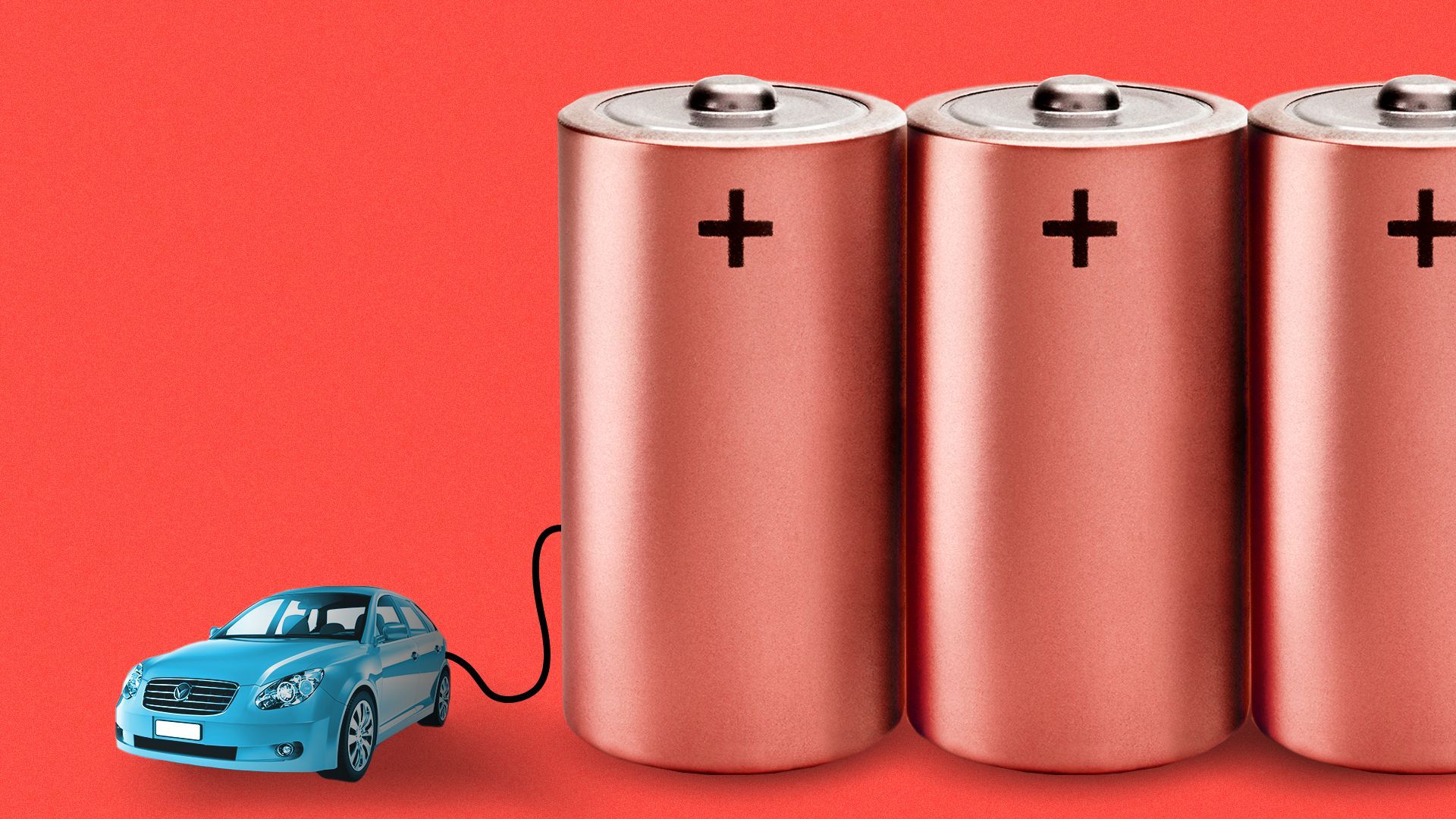| | | | | | | Presented By Okta | | | | Axios What's Next | | By Jennifer A. Kingson, Joann Muller and Erica Pandey ·Oct 21, 2021 | | There's a gold rush by automakers to build battery plants in the U.S. for electric vehicles — even though it isn't clear that the demand is there yet. - Today's What's Next photo comes from Axios publisher Nick Johnston, who's been traveling to cities where we're opening Axios Local newsletters and taking pictures of the 5G cell equipment he has noticed there.
- See something similar in your town? Send us a photo at whatsnext@axios.com.
Today's Smart Brevity count: 1,012 words ... 4 minutes. | | | | | | 1 big thing: Carmakers rush to build batteries for electric vehicles |  | | | Illustration: Annelise Capossela/Axios | | | | Almost every week, another major automaker announces a billion-dollar-plus investment in battery manufacturing, and with it, thousands of new American jobs, Joann Muller writes. Why it matters: Eyeing President Biden's climate agenda, carmakers are racing to create a domestic battery supply chain to support their aggressive rollout of electric vehicles by the end of the decade. - They want to avoid another crisis like the current semiconductor shortage, which forced them to slash vehicle production because they can't get enough computer chips from Asia.
Driving the news: This week, Toyota and Stellantis (Chrysler and Jeep's parent) joined the chorus of automakers planning to build giant battery factories in North America. - The moves follow other U.S. battery manufacturing commitments, by Ford and General Motors, as well as Korean battery suppliers SK Innovation and LG Chem.
- For now, these moves are ahead of demand. But forecasters predict the EV shift will occur quickly as more plug-in models are introduced and governments increase requirements for zero-emissions vehicles to fight climate change.
- When those pieces fall into place, the world's carmakers are likely to be in an all-out war to secure battery metals and other materials needed to produce them.
By the numbers: Americans purchase about 17 million vehicles a year, and Biden's goal is for half of them to be electric by 2030. - Each 30-gigawatt battery factory is enough to power about 300,000 vehicles, notes Kristin Dziczek, vice president at the Center for Automotive Research.
- That means it would take at least 30 battery factories — employing about 2,000 workers each — to meet Biden's 50% target (not accounting for the fact that half of cars sold in the U.S. are imported.).
- There are a total of 19 existing or planned cell manufacturing plants in the U.S., but not all of them are on the scale of Tesla's gigafactory in Nevada.
Yes, but: By 2030, the U.S. is still expected to account for less than 14% of global battery capacity, compared with China's 66%. - And despite pouring billions of dollars into battery cell production, the industry isn't doing nearly enough to prepare for a historic shift to electrification, experts say.
What to watch: While battery manufacturing plants get built at a record pace, the big question is how the U.S. will fill in the other gaps in the supply chain. Read the full story. |     | | | | | | 2. Amazon is now a bigger shipper in the U.S. than FedEx |  Reproduced from Supply Chain Dive; Chart: Axios Visuals Amazon is not primarily known as a logistics company, but in 2020 the company shipped more parcels than FedEx, Erica Pandey writes. Why it matters: Logistics is a $1.5 trillion business — and it has long been controlled by a handful of key players, like FedEx, UPS and the U.S. Postal Service. Now Amazon is poised to conquer it. What's happening: Amazon has 21% of the U.S. shipping market — right behind UPS (24%) and ahead of FedEx (16%). The USPS remains dominant with 38%, and all other shippers account for just 1% of the market, according to Pitney Bowes, which tracks the global shipping and e-commerce industry. - Amazon's rise is remarkable, as it had a zero share of the U.S. shipping market as recently as 2014, and it relied on legacy shippers like FedEx and UPS for all of its deliveries.
- Since then, Amazon has poured resources into building a network of warehouses, trucks, planes and delivery drivers. As it strengthened its own shipping arm, Amazon took its business away from the other shippers.
- Now, the company is turning shipping from a cost to a source of revenue by offering its logistics capabilities as a service.
But, but, but: Amazon still leans on legacy shippers for the last mile, Supply Chain Dive reports. That means even though more packages are coming from Amazon's shipping apparatus, they're getting passed off to other companies along the way. Read the full story. |     | | | | | | 3. The grim outlook for your orange juice |  Data: U.S. Department of Agriculture; Chart: Thomas Oide/Axios Florida's citrus crop is on pace to shrink again next year to its lowest total since 1945, if you don't count the destruction Hurricane Irma caused in 2017 to the state's already-depleted groves, Ben Montgomery writes in Axios Tampa Bay. Driving the news: The U.S. Department of Agriculture released its initial citrus crop forecast for the 2021-22 season: 47 million boxes of Florida oranges, down 11% from last season's 52.8 million. Of note: Fruit per tree was the lowest on record for both non-Valencia and Valencia oranges since the first year this number was collected, 1964-65. - Huanglongbing — or citrus greening — is to blame. The bacteria has infected 90% of the state's groves.
- Production has declined steadily since 2003, the season before citrus greening emerged as a threat to the $9 billion industry.
Read the full story. |     | | | | | | A message from Okta | | Protect customers with Okta's modern identity solutions | | |  | | | | Retailers around the world use Okta to power their most important customer-facing initiatives. Here's why: Engaging your customers online is essential – and keeping them safe is crucial. Learn how Okta can support your most important customer-facing initiatives. | | | | | | 4. The first novel written entirely in Slack messages |  | | | Photo: Penguin Random House | | | | The debut novel of Calvin Kasulke, a Brooklyn-based writer, is written entirely in Slack messages — with mixed results, according to Amazon reviewers, Jennifer A. Kingson writes. Why it matters: Social commentary on pandemic-era workplace culture is in its infancy, and this may be one of the opening salvos. TechCrunch describes the book's premise this way: "What if you got trapped inside of your office's Slack workspace, and Slackbot took over your corporeal form?" - The protagonist, Gerald, is "literally stuck inside Slack," TechCrunch says, and "can't commute to the office since he no longer has control of his body.
- "Within their Slack workspace, the characters deal with a dog food publicity crisis, in-office romances and fights over who gets Gerald's desk by the window while he 'works from home.'"
What they're saying: The author tells "Good Morning America": "Even though the book is written entirely in Slack chats, you don't need to ever have used Slack or to even really know what Slack is to read this book." The bottom line: There are raves and pans for the book, but general agreement that it's highly innovative. - Publisher's Weekly calls it "ambitious but underwhelming."
|     | | | | | | 5. Photo of the day |  | | | A 5G cell tower in Nashville, Tenn. Photo: Nicholas Johnston/Axios | | | | What's Next: 5G on every block Axios' publisher, Nicholas Johnston, writes: "This appears to be a new 5g cell tower in Nashville — I've seen them in D.C., Philly, Charlotte and other cities. "It's a sign of the added infrastructure needed for 5g and how cities try to make them unobtrusive." |     | | | | | | A message from Okta | | Give your workforce secure access to what they need the most | | |  | | | | With Okta, your organization can secure and enable employees, contractors, and partners --- wherever they are, and whatever they do. Your people are your future. Protect them. Learn why companies around the world trust Okta for workforce identity. | | | | Was this email forwarded to you? Get the daily dose of What's Next magic by signing up for our free newsletter here. |  | | It'll help you deliver employee communications more effectively. | | | | | | Axios thanks our partners for supporting our newsletters. If you're interested in advertising, learn more here.
Sponsorship has no influence on editorial content. Axios, 3100 Clarendon Blvd, Suite 1300, Arlington VA 22201 | | | You received this email because you signed up for newsletters from Axios.
Change your preferences or unsubscribe here. | | | Was this email forwarded to you?
Sign up now to get Axios in your inbox. | | | | Follow Axios on social media:    | | | | | |










No comments:
Post a Comment